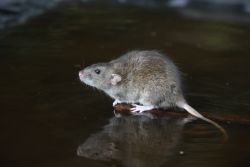Norway Rat
 Description:
Description:
A relatively large member of the mouse family with coarse light to dark brown hair that lightens as it reaches the sides, reaching a tan on the undersides. The ears are large, rounded and naked, but shorter than the Black Rat’s. The tail is naked and shorter than the length of the body.
Appearance:
They are averaging 15.5 inches in length (not including their tail, which makes up 45% of their total length) and weighs roughly 14 ounces. Males are larger than females.
Lifecycle:
Females may come into heat every 4 or 5 days, and they may mate within a day or two after a litter is born. Breeding often peaks in spring and fall, with reproductive activity declining during the heat of summer and often stopping completely in winter, depending on habitat. These seasonal trends are most pronounced in more severe climates. The average female rat has 4 to 6 litters per year and may successfully wean 20 or more offspring annually.
Habits:
Norway Rats inhabit the same spaces humans do and pretty much anywhere that offers food and shelter. In the wild, they will occupy a wide variety of habitats, including woodlands and open fields. Crop land is preferred in the wild. Nests are made from grass, leaves, twigs, paper, or anything they can find and are often built near sources of water. Burrows are often dug for shelter and nests and can be highly complex with multiple rooms and food storage space. Rats are opportunistic foragers. They will grab and eat pretty much anything they can. Human food and trash make up a large part of their diet. In the wild they will feed on seeds, fruit, plant material, mice, birds, small lizards, insects, fish, and fungus. They prefer meat.